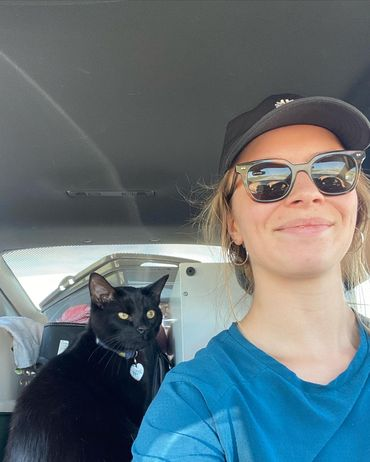
And I love it.
WFH feels more like living in your office than working from home.
Me, a year ago (yikes)
When I joined Statsig, one of the big appeals was the in-person experience. I even moved from Denver to Seattle specifically to go into the office. But life happens, and a year after moving to Seattle, I relocated to Philadelphia to support my spouse as he started his MBA—and now I’m loving working from home.
Remote work felt very isolating at my previous job. I lived alone- so the concept of “having more time for my family” didn’t apply. If anything, I just spent more time festering in my sorrows.

As a junior employee, I also didn’t have any context on how my job should be done. There’s a lot of learning osmosis that happens in-office, and I missed out on this. I often ended up re-inventing the wheel and overcomplicating tasks that had simple fixes.
So, when I started looking for a new job, Statsig’s in-person culture was like a beacon in the night. I packed up my cats and convinced my boyfriend of less than a year to move to Seattle with me, and off we went.

I was employee #17, and the only salesperson at the time, so there was a ton of learning to do in the office. It was exactly the in-person experience I was looking for: I made friends with the engineers and product managers, and loved the sense of community.
But I also struggled to focus and complete tasks with the open office plan. I was used to the complete silence of WFH. It was shocking to see how everyone else was able to laser-focus and knock out projects when I felt like my attention was being pulled in a million directions.
After 6 months of working in-office, I got evaluated for, and was diagnosed with, ADHD.
Flash forward four more months—my then-boyfriend-now-spouse (if he’s on my insurance, I get to call him my spouse ) got into a moonshot MBA program in Philly, so we made our second cross-country move in a year. Coincidentally, Statsig had just hired our first east coast Account Exec, and needed more folks in the East for timezone coverage anyways. Sometimes it just works out. 🤷
I’ve now been WFH for 3 months, and couldn’t be happier. The first time I worked from home, I lived by myself. Now I have a family—and WFH means I’m able to be around for important moments.
Also, cold calling is way less unpleasant when I’m in my pjs on the couch.
There’s a huge benefit to being in person—if your teammates are also there. Our design, product, and engineering teams are all in-person, so they do a ton of collaboration in-office. But, our go-to-market team is mostly remote, so it’s more effective for us to do occasional meet-ups.
Especially with ADHD, having a flexible work environment means I’m more effective, and more empowered to make my own decisions about how I spend my time. Because sometimes those decisions are “eat a couple hot dogs during standup,” and that’s okay.